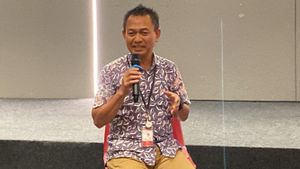
JAKARTA - Pigs are riddled animals. For Muslims or Jews, pigs are considered unclean animals. All content related to pigs is believed to have no principle of benefit But that's not always the case.
Pig narrative for the people of West Irian (Papua), Toraja and Papua New Guinea, for example. They see pigs as sacred animals. Pigs may only attend sacred rituals and events: weddings and funerals. Moreover, the Pig is a “luxurious” offering to the ancestors.
Whenever the presence of pigs in Muslim and Jewish families is considered taboo. In the eastern part of Indonesia, to be precise in Amungme, Timika has a very high love for pork. In fact, one cannot truly become a human without being accompanied by a pig. To the Amungme people, pigs are like family members.
They take care of it, name the pig, and make it a pen. This love, however, is not like the love of Indian Hindus for cows. The love of pigs means sacrificing and eating pork on special occasions which are commonly known as pig feasts.
It's not just one or two families that raise pigs. This is because almost all Amungme residents have always chosen pigs, while they gardened. The animal has traditionally been of high symbolic and sacred value.
In this context, Amungme residents recognize pigs in four symbols. First, the pig as a symbol for solving problems. Second, pigs as determining social status. the three pigs as a symbol of legal payment.

Pigs in Papua (Source: geheugen.delpher.nl)
“In addition, pigs are also considered as a means of solving problems, especially overcoming quarrels between clan groups, as one of the conditions for reconciliation between one clan and another is a pig feast. Pigs are a symbol of legal marriage payments. Even though the Amungme people have lived in Timika for a long time, and they have absorbed some of the city's norms, the problem of dowry payment is still done traditionally, ”writes in the book Masyarakat Terasing Amungme di Irian Jaya (1995).
The same is true for Toraja society. The presence of pigs is an important part of every ritual, such as the rambu tuka (life ritual) or rambu solo (death ritual) ritual. These two rituals prove that pigs have always been an inseparable part of the life cycle of the Toraja people. There are also many other things. The pig is also known as a sign of peace, condolences, blessings, brotherhood, gratitude and marriage.
"That pigs have a very important place in the life of the Toraja people. Pigs are not only interpreted as a sacrifice, but for Toraja people, pigs also hold other meanings such as reconciliation, relationality, and economic value. Nor was the pig first sacrificed so that the family might receive a blessing, but he was sacrificed to see the marks on the blood, bile, and heart. A pig that is sacrificed may have a sign that does not bring good luck to the family, but it is a disaster, "said Yekhonya FT Weighing in the book Theology of Contextual and Local Wisdom of Toraja (2020).
Pig feast in Papua New GuineaAmong the many tribes that make pigs sacred animals, the Tsembaga Maring Tribe who lives in the Bismarck Mountains, Papua New Guinea should not be overlooked. As well as being known for being pork lovers, they are also known for hosting a massive pork-eating party called "Kaiko."
A long description of the pork-eating binge has even been written since 1963. Professor Roy Rappoport from the University of Michigan is the mastermind behind it. He became the first person to study the interaction between pigs and the Tsembaga Maring tribe.
Rappoport's research reveals that Kaiko is carried out every 12 years. The pork feast lasted for a whole year. The purpose of the party was none other than a form of ceasefire between the Tsembaga Maring clans.
Moreover, this effort is to control a herd of pigs that begin to compete fiercely with humans for food. At that time, all the pork that was there was eaten. In succession, the villagers and their guests devoured large quantities of pork.
"The behavior described by Rappaport is a ceremonial cycle with the slaughter of pigs which takes place during the transition between one period and another during a period of ceasefire interspersed with wars," wrote Yunita T. Winarno in an Anthropological News entitled Difference between Interpretation and Neofunctionalism and Action. Rational Individuals: Case Cycle Maring Ceremony in Papua New Guinea (1986).
"The ceremonial cycle has an important function as a self-regulating mechanism that maintains a balance between the population and the non-human components of their environment, and with other Maring-speaking population groups in a wider environment," he added.

Thereafter, in the two or three months after Keiko, the clans again engaged in armed warfare with their enemies. Many victims fell, and some areas of control were lost, some were conquered.
When the two rival clans find that they are short of adult pigs for the blessing of their ancestors, the war is abruptly stopped. Then the warring parties began repairing the holy sites to plant small trees known as rumbin.
Each adult male member of each clan is required to participate in this ritual. They must place their hands on the rumbim shoots when they are driven into the soil. In the same breath, the war shaman then spoke to the ancestors explaining that they had lost the pig and were grateful that they were still alive.
The shaman was also the actor who convinced the ancestors that the war had now ended. In that sense, hostilities will not continue as long as the rumbim remains in the ground.
"From then on, the thoughts and efforts of the living will be directed towards raising pigs. When a new herd of pigs has been raised and enough for a Keiko, as an expression of proper gratitude to the ancestors, then the knights think about uprooting the rumbim and returning to the battlefield, "concluded Anthropologist Marvin Harris in the book Cows, Pigs, War, and Builders. Magic (2019).
illustration:
1, Pigs in Papua | geheugen.delpher.nl
2. Pigs in Sulawesi | geheugen.delpher.nl
3. Hunting pigs in Kalimantan | geheugen.delpher.nl
The English, Chinese, Japanese, Arabic, and French versions are automatically generated by the AI. So there may still be inaccuracies in translating, please always see Indonesian as our main language. (system supported by DigitalSiber.id)












